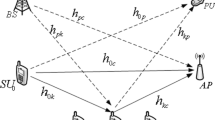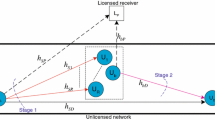Abstract
In this paper, we examine an adaptive decode-and-forward cooperative protocol under interference constraint. In the proposed protocol, relying on the obtained instantaneous signal-to-noise ratios (SNRs), a direct link or relay link is used to transmit data from the secondary source to the secondary destination. In addition, once the relay link is used, the secondary source and relay must adapt their transmit power to maximize the instantaneous SNR of this link. To evaluate the performance of the proposed protocol, we derive closed-form lower-bound and upper-bound expressions for the outage probability over Rayleigh fading channel. Finally, various Monte-Carlo simulations are presented to verify our analysis and compare the performance of the proposed protocol with that of the direct transmission protocol in underlay cognitive network.





Similar content being viewed by others
References
Mitola, J., & Maguire, G. Q. (1999). Cognitive radio: Making software radios more personal. IEEE Personal Communications, 6, 13–18.
Simeone, O., Stanojev, I., Savazzi, S., Bar-Ness, Y., Spagnolini, U., & Pickholtz, R. (2008). Spectrum leasing to cooperating secondary ad hoc networks. IEEE Journal on Selected Areas in Communication, 26, 203–213.
Elkourdi, T., & Simeone, O. (2012). Spectrum leasing via cooperation with multiple primary users. IEEE Transactions on Vehicular Technology, 61, 820–825.
Han, Y., & Ting, S. H. (2009). Cooperative decode-and-forward relaying for secondary spectrum access. IEEE Transactions on Wireless Communications, 8, 4945–4950.
Han, Y., Ting, S. H., & Pandharipande, A. (2010). Cooperative spectrum sharing with distributed secondary user selection. 2010 IEEE International Conference on Communications (ICC) (pp. 1–5).
Duy, T. T., & Kong, H. Y. (2013). Performance analysis of two-way hybrid decode-and-amplify relaying scheme with relay selection for secondary spectrum access. Wireless Personal Communications, 69, 857–878.
Guo, Y., Kang, G., Zhang, N., Zhou, W., & Zhang, P. (2010). Outage performance of relay assisted cognitive-radio system under spectrum-sharing constraints. Electronics Letters, 46, 182–184.
Lee, J., Wang, H., Andrews, J. G., & Hong, D. (2011). Outage probability of cognitive relay networks with interference constraints. IEEE Transactions on Wireless Communication, 10, 390–395.
Ding, H., Ge, J., da Costa, B., & Zhuoqin Jiang, D. (2011). Asymptotic analysis of cooperative diversity systems with relay selection in a spectrum-sharing scenario. IEEE Transactions on Vehicular Technology, 60, 457–472.
Duong, T. Q., da Costa, D. B., Elkashlan, M., & Bao, V. N. Q. (2012). Cognitive amplify-and-forward relay networks over Nakagami-m fading. IEEE Transactions on Vehicular Technology, 61, 2368–2374.
Yan, Z., Zhang, X., & Wang, W. (2011). Exact outage performance of cognitive relay networks with maximum transmit power limits. IEEE Communications Letters, 15, 1317–1319.
Li, D. (2012). Performance analysis of MRC diversity for cognitive radio systems. IEEE Transactions on Vehicular Technology, 61, 849–853.
Khuong, H.-V. (2013). Exact outage probability of underlay cognitive cooperative networks over rayleigh fading channels. Wireless Personal Communications, 70, 1001–1009.
Ghasemi, A., & Sousa, E. S. (2007). Fundamental limits of spectrum-sharing in fading environments. IEEE Transactions Wireless Communications, 6, 649–658.
Peha, J. M. (2005). Approaches to spectrum sharing. IEEE Communications Magazine, 43, 10–12.
Ban, T. W., Choi, W., Jung, B. C., & Sung, D. K. (2009). Multi-user diversity in a spectrum sharing system. IEEE Transactions on Communications, 8, 102–106.
Pei, E., Wang, S., & Zhang, Z. (2011). Capacity and optimal power allocation for spectrum-sharing with primary transmission consideration in fading channels. IEEE Communications Letters, 15, 389–391.
Liu, P., Tao, Z., Lin, Z., Erkip, E., & Panwar, S. (2006). Cooperative wireless communications: A cross-layer approach. IEEE Wireless Communication, 13, 84–92.
Laneman, J. N., Tse, D. N. C., & Wornell, G. W. (2004). Cooperative diversity in wireless networks: Efficient protocols and outage behavior. IEEE Transactions on Information Theory, 50, 3062–3080.
Gradshteyn, I., & Ryzhik, I. (2007). Table of integrals, series, and products (7th ed.). New York: Academic Press.
Acknowledgments
This work was supported by 2014 Special Research Fund of Electrical Engineering at University of Ulsan.
Author information
Authors and Affiliations
Corresponding author
Appendices
Appendix A
1.1 Proof of (4)
For ease of presentation, we set \(y=P_{S}^{CC}\) and from (2), we have \(P_{R}^{CC} =\frac{I_{P} }{\gamma _{3} }-y\). Hence, the optimization problem can be formulated as follows:
where constraints (14) and (15) are obtained by \(P_{S}^{\textit{CC}} \le I_{P} /\gamma _{3}\) and \(P_{R}^{\textit{CC}} \le I_{P} /\gamma _{4}\), respectively.
Next, we consider three cases as follows:
- Case 1::
-
\(\frac{\gamma _{3} }{\gamma _{4} }\ge 1\)
In this case, the constraint (15) is omitted and the function \(f\left( y \right) \) obtains the optimal value, i.e., \(f_{\max } \left( y \right) =\frac{I_{P} \gamma _{1} \gamma _{2} }{\left( {\gamma _{1} +\gamma _{2} } \right) \gamma _{3} }\), as \(y\gamma _{1} =\left( {\frac{I_{P} }{\gamma _{3} }-y} \right) \gamma _{2}\) or \(y=\frac{I_{P} \gamma _{2} }{\left( {\gamma _{1} +\gamma _{2} } \right) \gamma _{3} }\).
- Case 2::
-
\(\frac{\gamma _{1} }{\gamma _{1} +\gamma _{2} }\le \frac{\gamma _{3} }{\gamma _{4} }<1\)
In this case, because \(\frac{I_{P} }{\gamma _{3} }-\frac{I_{P} }{\gamma _{4} }\le \frac{I_{P} \gamma _{2} }{\left( {\gamma _{1} +\gamma _{2} } \right) \gamma _{3} }\), similar to Case 1, the optimal value of \(f\left( y \right) \) is \(f_{\max } \left( y \right) =I_{P} \frac{\gamma _{1} \gamma _{2} }{\gamma _{3} \left( {\gamma _{1} +\gamma _{2} } \right) }\) when \(y=I_{P} \frac{\gamma _{2} }{\gamma _{3} \left( {\gamma _{1} +\gamma _{2} } \right) }\).
- Case 3::
-
\(\frac{\gamma _{3} }{\gamma _{4} }<\frac{\gamma _{1} }{\gamma _{1} +\gamma _{2} }\)
In this case, because \(\frac{I_{P} }{\gamma _{3} }-\frac{I_{P} }{\gamma _{4} }>\frac{I_{P} \gamma _{2} }{\left( {\gamma _{1} +\gamma _{2} } \right) \gamma _{3} }\), so \(y\gamma _{1} >\left( {\frac{I_{P} }{\gamma _{3} }-y} \right) \gamma _{2}\) and \(f\left( y \right) =\left( {\frac{I_{P} }{\gamma _{3} }-y} \right) \gamma _{2}\). Similar to Case 2, the function \(f\left( y \right) \) obtains the optimal value \(f_{\max } \left( y \right) =I_{P} \frac{\gamma _{2} }{\gamma _{4} }\) as \(y=\frac{I_{P} }{\gamma _{3} }-\frac{I_{P} }{\gamma _{4} }\).
From results obtained in Case 1, Case 2 and Case 3, the optimal solution \(f_{\max } \left( y \right) \) can be given as follows:
From (16) and \(\gamma _{\max }^{CC} =f_{\max } \left( y \right) /N_{0}\), we obtain (4).
Appendix B
1.1 Proof of (9)
Considering the probability \(\Pr \left[ {\frac{\gamma _{0} }{\gamma _{3} }<\rho ,\frac{\gamma _{1} }{\gamma _{1} +\gamma _{2} }<\frac{\gamma _{3} }{\gamma _{4} } ,\frac{\gamma _{1} \gamma _{2} }{\gamma _{3} \left( {\gamma _{1} +\gamma _{2} } \right) }<\rho } \right] \) in (8); applying the inequality \(\frac{\gamma _{1} \gamma _{2} }{\gamma _{1} +\gamma _{2} }\le \min \left( {\gamma _{1}, \gamma _{2} } \right) \), it can be bounded as
Considering the probability \(J_{1}\) in (17), it can be formulated as
In (18), \(\Pr \left[ {\max \left( {\gamma _{4} ,\frac{\gamma _{0} }{\rho },\frac{\gamma _{2} }{\rho }} \right) <x,\gamma _{1} \ge \gamma _{2} } \right] \) can be calculated as
Substituting (19) into (18) and after some simple manipulation, we get
Now, considering the probability \(J_{2}\) in (17), using the inequality \(\gamma _{1} <\rho \gamma _{3}\), we have
Similar to (18), we can formulate the probability \(J_{3}\) in (21) as follows:
From (22) and after some manipulation, we obtain
Now, considering the probability \(\Pr \left[ {\gamma _{0} <\rho \gamma _{3}, \frac{\gamma _{1} }{\gamma _{1} +\gamma _{2} }\ge \frac{\gamma _{3} }{\gamma _{4}}, \gamma _{2} \le \rho \gamma _{4} } \right] \) in (8); it can be rewritten as follows:
With \(\gamma _{1} \ge \gamma _{2}\), we have \(\frac{\gamma _{1} +\gamma _{2} }{\gamma _{1} }\frac{\gamma _{3} }{\gamma _{4} }<\frac{2\gamma _{3} }{\gamma _{4} }\) and with \(\gamma _{1} <\gamma _{2}\) and \(\gamma _{2} \le \rho \gamma _{4}\), we obtain \(\frac{\gamma _{1} +\gamma _{2} }{\gamma _{1} }\frac{\gamma _{3} }{\gamma _{4} }\le \frac{\gamma _{1} +\gamma _{2} }{\gamma _{1} \gamma _{2} }\rho \gamma _{3} \le \frac{2\rho \gamma _{3} }{\gamma _{1}}\). Hence, (24) can be bounded by
Considering the probability \(J_{4}\) in (25), it can be calculated as
Next, we calculate the probability \(J_{5}\) in (25) as
From (8), (17), (21) and (25), the outage probability \(P_{CC}^{out}\) can be bounded as
Hence, substituting the results in (20), (23), (26) and (27) into (28), we obtain (9).
Appendix C
1.1 Proof of (10)
Considering the probability \(\Pr \left[ {\frac{\gamma _{0} }{\gamma _{3} }<\rho ,\frac{\gamma _{1} }{\gamma _{1} +\gamma _{2} }<\frac{\gamma _{3} }{\gamma _{4}}, \frac{\gamma _{1} \gamma _{2} }{\gamma _{3} \left( {\gamma _{1} +\gamma _{2} } \right) }<\rho } \right] \) in (8); it can be bounded as
Setting \(X=\frac{\gamma _{1} \gamma _{2} }{\gamma _{1} +\gamma _{2}}\), the CDF of \(X\) is given as
where \(K_{1} \left( . \right) \) is modified Bessel Function of the second kind [20].
From (29) and (30), we can formulate \(I_{1}\) as
Now, we have the following integral:
where \(\alpha _{1}, \,\alpha _{2}\) and \(\alpha _{3}\) are positive real numbers, and \(\cosh ^{-1}\left( x \right) \) is inverse hyperbolic cosine, which is given as \(\cosh ^{-1}\left( x \right) =\ln \left( {x+\sqrt{x^{2}-1}} \right) \).
Substituting the PDF \(f_{\gamma _{3} } \left( x \right) =\lambda _{3} \exp \left( {-\lambda _{3} x} \right) \), the CDF \(F_{\gamma _{0} } \left( {\rho x} \right) =1-\exp \left( {-\lambda _{0} \rho x} \right) \), the CDF \(F_{x} \left( {\rho x} \right) \) obtained in (30) and the result obtained in (32) into (31), we obtain
Similarly, the outage probability \(\Pr \left[ {\gamma _{0} <\rho \gamma _{3}, \frac{\gamma _{1} }{\gamma _{1} +\gamma _{2} }\ge \frac{\gamma _{3} }{\gamma _{4} } ,\gamma _{2} \le \rho \gamma _{4} } \right] \) in (8) can be bounded as follows:
From (8), (29), (33) and (34), we have \(P_{CC}^{out} <P_{CC}^{UB}\), where \(P_{CC}^{UB}\) is given as in (10).
Rights and permissions
About this article
Cite this article
Duy, T.T., Kong, HY. Adaptive Cooperative Decode-and-Forward Transmission with Power Allocation Under Interference Constraint. Wireless Pers Commun 74, 401–414 (2014). https://doi.org/10.1007/s11277-013-1292-8
Published:
Issue Date:
DOI: https://doi.org/10.1007/s11277-013-1292-8




